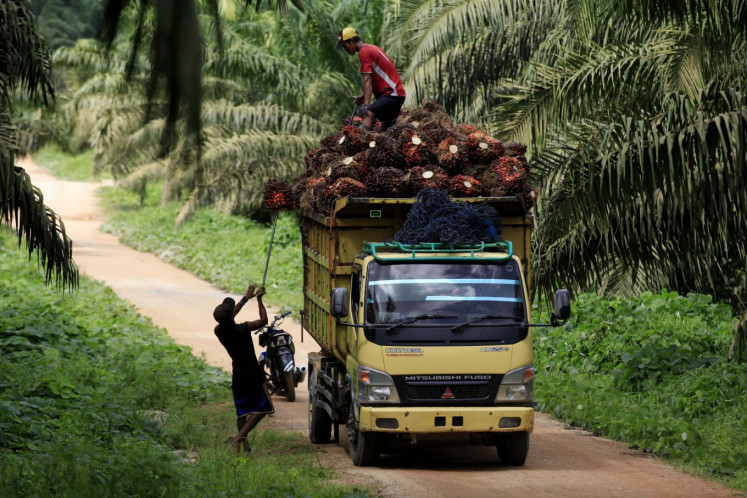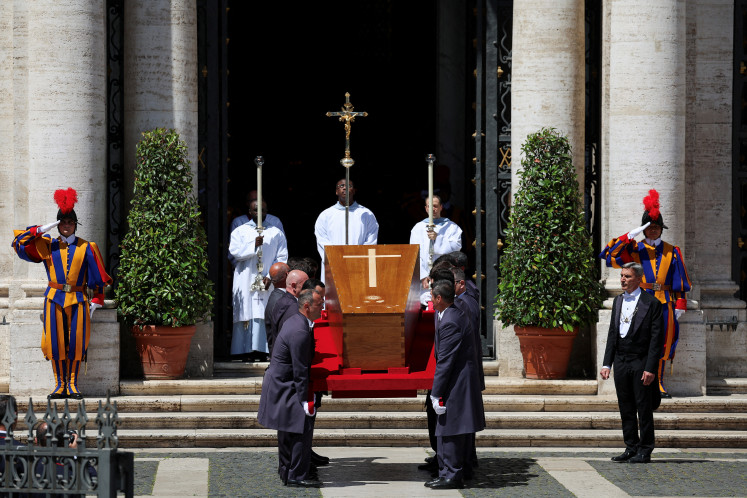Achieving purity via Ganesh
For your delectation: A religious leader offers sweets brought by devotees to a Ganesh statue
Change text size
Gift Premium Articles
to Anyone

F
span class="caption" style="width: 558px;">For your delectation: A religious leader offers sweets brought by devotees to a Ganesh statue. Ganesh is known to love modak (sweet dumplings) and ladoo (ball-shaped sweets).
He is plump, cute and accompanied by a mouse. He has the head of an elephant but the body of a human with an extra pair of arms.
His tusk has deliberately been broken for use as a replacement pen, for he was transcribing the Mahabharata when the ink ran out so he broke his own tusk and used it for that purpose. Also known as the “elephant god”, Ganesh is worshipped by Hindus worldwide.
The birthday of Ganesh is also known as Ganesh Chathurthi. From 1883 onward, the festival was celebrated in private, mostly in the Maharashtra region of India. It was Lokmanya Tilak — Indian nationalist, social reformer and freedom fighter — who popularized the festival of the Ganesh Chathurthi. He wanted to recapture nationalism through religious belief. He was the first person to set out huge idols of Ganesha to be immersed in the sea on the 10th day of the festival.

Devotees have continued the tradition of celebrating the Ganesh Chathurthi in India by organizing mini shows with small skits, poems and songs. The country grinds to a halt during these celebrations. Some people prefer to worship Ganesh as a group, contributing a sum that can buy a huge idol. Some Ganesh statues can be as high as 3-meters-tall in cities like Mumbai. With so many people pitching in for an idol, a long colorful procession takes place as the Ganesh is taken to the sea.

The deity comprises five elements: gold, silver, bronze, copper and steel. Every year, devotees bring their idols to the temple to celebrate Ganesh Chathurthi. On the first day of merrymaking, the idol is “brought to life” through chanting and a fire ceremony.
After Lord Ganesh has been invoked, he is “fed” with delicious meals and sweets. He is known to love eating modak (sweet dumplings) and ladoo (ball-shaped sweets). Whatever is cooked at home for the day by the devotee should be served to Ganesh from the first through the 11th day. Devotees gather every evening to sing religious hymns.
Like some others, Rachna, a native of Jakarta, keeps her Ganesh idol at home during Ganesh Chathurthi festivities. She invites other devotees to keep their idols at her house too. This year, 55 devotees kept their Ganesh idols at her house. Rachna has been celebrating Ganesh’s birthday for over 20 years now. The first time she kept the idol at home it was for to wish that her sister-in-law could find a husband.
Three days into the festival, Rachna said her sister-in-law became engaged. Rachna did not observe the festival the following year. When her mother-in-law was struck with cancer, the entire family could not bear to see her in pain. They prayed to God to take her away peacefully. They decided to keep the Ganesh idol for that year’s Ganesh Chathurthi. Rachna said her mother-in-law passed away the next day.

“It is just a statue but what is important is our faith behind it. As human beings, we need to believe in something. Even if you are a Christian or Muslim you need to have something in your heart. You need a destination in life,” Rachna said recently.
The first day of the festival at Rachna’s house starts with the Navagraha Pooja (worship of the nine planets), then Ganesh is bathed in milk while chanting his 108 names, followed by the thread ceremony and the Sthapna (a prayer dedicated to the sanctity of the idol). Rachna notes, “In my house you will see many different, colorful Ganesh idols on one platform. In India it is just one huge Ganesh idol for each community.”
On the last day, devotees gather and recite closing prayers. The Ganesh idol is ready to be taken to the sea to be immersed. Devotees say their goodbyes to their idols and finally immerse the Ganesh idol. This symbolizes the washing away of negative aura in the environment, and the purification of hearts and homes.
“For me Ganpathiji means Lord of the Beginnings and remover of obstacles. I have immense faith in Him. He will give you the strength to confront life’s problems,” Varsha Ramchandani, another devotee, said.
— Photos by Aruna Harjani









